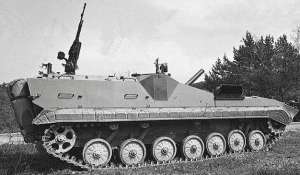| Designation: | PRAM-S |
 |
|---|---|---|
| Manufacturer: | ZTS - Special, a.s. | |
| Product type: | Armoured Vehicles | |
| Name: | Self-propelled mortar |
In 1990, ZTS completed the prototype of a 120 mm self-propelled mortar system called the PRAM-S.
The Russian-designed BMP-1 and the more recent BMP-2 were manufactured under licence in Czechoslovakia for some years. As far as it is known there has been no recent production of the BMP-2 in Slovakia.
In early 1992, ZTS stated that the PRAM-S was in production and would be deployed in batteries of six systems. With the break-up of the former Czechoslovakia, production and marketing of this system is now carried out by ZTS in the Slovak Republic.
It is understood that of the 12 systems built, six are in service with the Czech Republic and the other six with the Slovak Republic.
Although production of the PRAM-S 120 mm self-propelled mortar system was completed some years ago, it is still being offered on the export market by ZTS of Slovakia and production can resume if further significant orders are placed.
It is considered that if production did start again it would probably be integrated on a more recent chassis. This would probably be of Western design.
The PRAM-S 120 mm self-propelled mortar system is based on a modified BMP-2 infantry fighting vehicle chassis, which has had its turret removed and roof raised to accept a new 120 mm mortar system that can be aimed, loaded and fired under complete armour protection.
The chassis of the original BMP-2 IFV has been lengthened and raised at the rear and now has a total of seven road wheels compared to the standard vehicle which has six. The drive sprocket is at the front, idler at the rear and there are three track-return rollers. Hydraulic shock-absorbers are provided for the first and last road wheel stations.
The driver is seated at the front left with the engine compartment to his right, with the area to the rear of the vehicle being raised to provide sufficient space for the 120 mm mortar, ammunition and crew.
Mounted in the forward part of the roof is the 120 mm breech-loaded mortar which has a traverse of 15° left and right and can be elevated from +40 to +80°. Elevation and traverse of the 120 mm mortar is manual.
Maximum range of the 120 mm mortar is 8,036 m with minimum range being 504 m, which in both cases depends on the type of 120 mm mortar ammunition (for example projectile and propelling charge) being used.
Maximum rate of fire using the Czech D charge is 18 to 20 rds/min, 40 rounds in 5 minutes and 70 rounds in 10 minutes. The mortar can be fired on longitudinal slopes of up to 5° and transverse slopes of up to 5°.
On coming to a halt, the first rounds can be fired in 1 minute and the system can come out of action 1 minute after the last round has been fired.
When travelling, the 120 mm mortar is at the minimum elevation angle and when required for action armoured covers unfold either side of the mortar to allow for greater elevation.
The commander is seated to the right of the 120 mm mortar and is provided with a roof hatch, three day periscopes and an infra-red searchlight.
The gunner is seated opposite the commander, has a roof-mounted day laying system and can enter the vehicle via a forward-opening door in the left side of the hull that is also provided with a vision block.
The vehicle commander operates the R-123 UHF/VHF radio with the antenna for this being located forward and to the left of the driver's hatch.
In addition, there is a hatch in the roof of the vehicle to the rear of the commander on which an externally mounted 12.7 mm NVS machine gun is fitted for local and anti-aircraft defence.
The loader is seated towards the rear of the mortar and is responsible for preparing the mortar bombs and filling the automatic loader from the ammunition containers to the left and right rear of the combat compartment.
The 120 mm mortar bombs are stowed vertically, the loading system being chain driven with a rammer provided to ram the mortar bombs into the mortar.
In the rear of the vehicle is a door for ammunition resupply and 80 rounds of 120 mm mortar ammunition are carried, of which 21 rounds are in the conveyor and 59 rounds in the magazines.
The PRAM-S is fully amphibious, being propelled in the water by its tracks, and is fitted with an NBC system and a full range of night vision devices. The vehicle can lay its own smoke screen by injecting diesel fuel into the exhaust outlet located on the right side of the hull which, when compared to Russian BMP-1/BMP-2 type vehicles, has a distinctive cowl-type shroud.
In late 2001, it was reported that a number of enhancements were under active consideration for this system, including integrating on a wheeled platform. As of late 2007 the wheeled version remained at the concept stage.
|
||||||||||||||||||||||||||||||||||||||||||||||||||||||||
 |
 |
